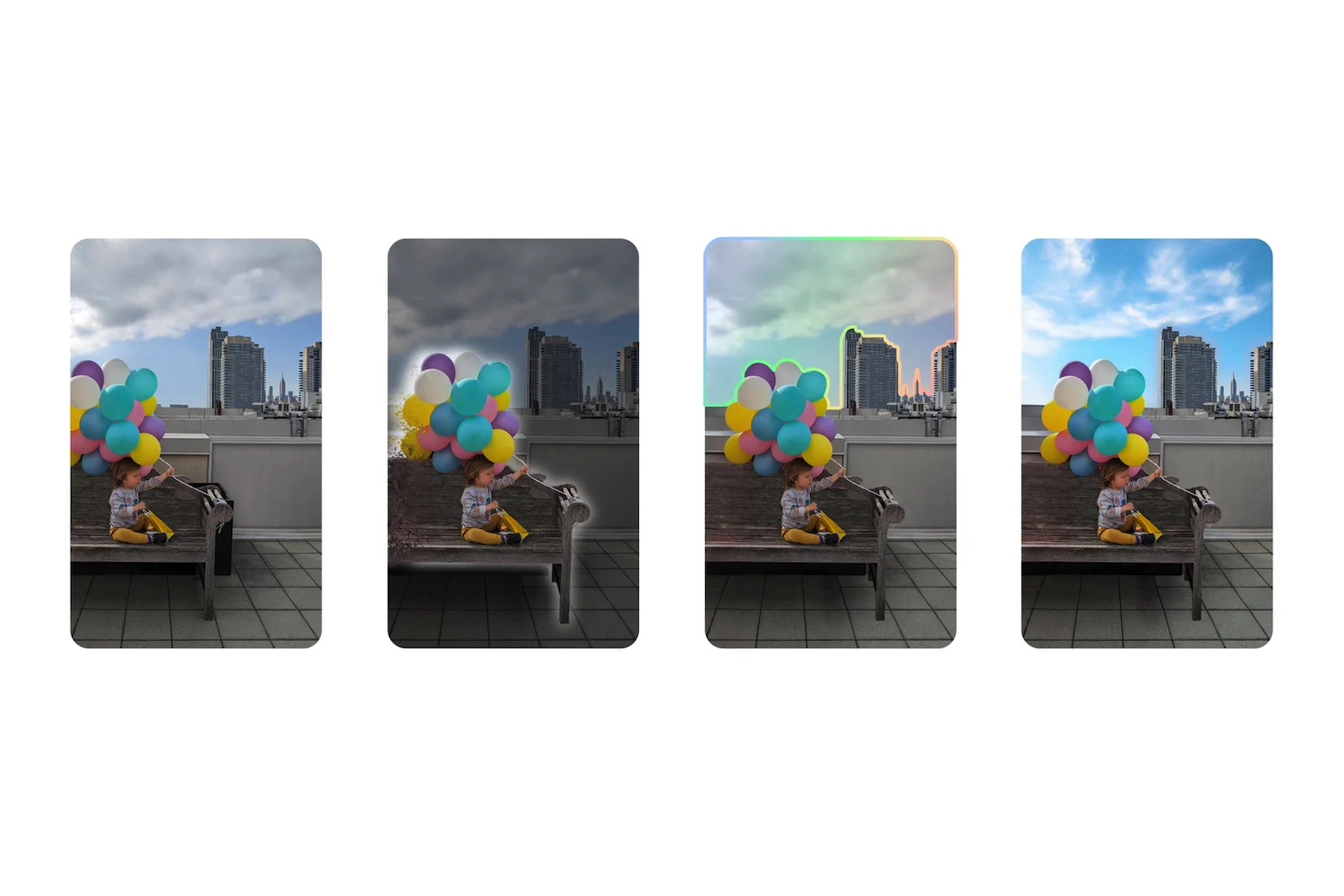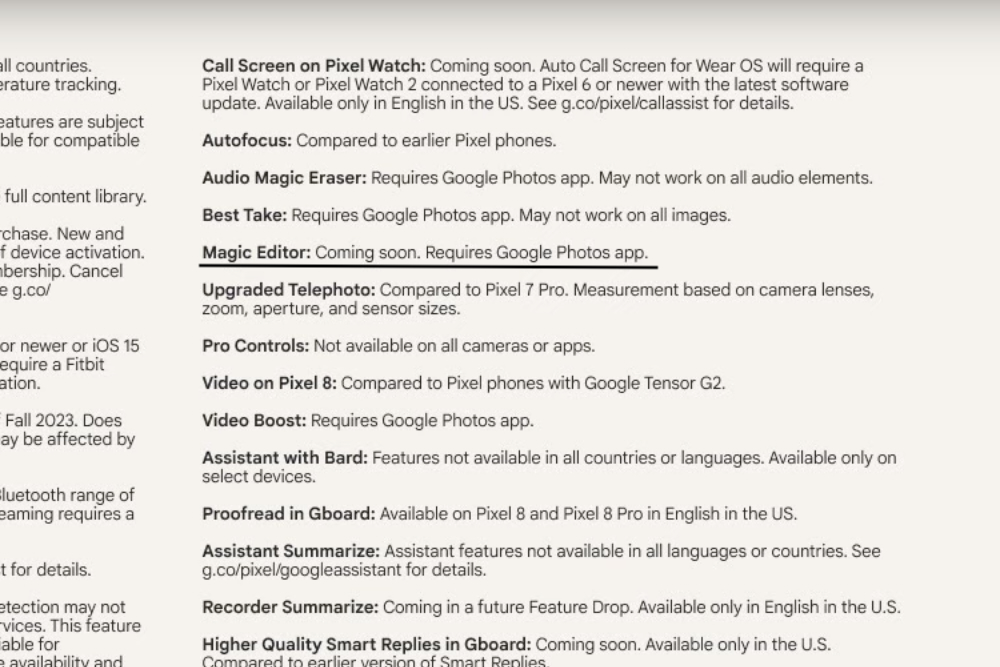
Google talked about a lot of products and new software features during its Pixel 8 launch event, and it was easy to get overwhelmed by all the excitement. It was also easy to miss that quite a few of the features aren’t going to be available when the Google Pixel 8, Google Pixel 8 Pro, and Google Pixel Watch 2 go on sale.
It’s a bit of a trend in 2023 — Apple just did the same with Double Tap on the Apple Watch Series 9 — and a frustrating one, especially if a particular feature really caught your attention. In the case of the Pixel 8 lineup, there are 10 new features that look promising, but are all tarnished by delayed availability.
To make sure you are fully informed about what’s coming soon rather than available now, here’s our breakdown of what’s not going to be on your new Pixel device when you buy it.
Magic Editor
Google’s image-editing tool is so powerful that it can change the entire look of your photo, from the framing to the weather conditions. It was originally revealed during Google I/O earlier this year. During the Pixel event, it appeared as if Magic Editor would be immediately available on the Pixel 8 series, but the small print at the end of the presentation states that Magic Editor is “coming soon.” This is also printed as a disclaimer in the advertisement for the feature. We’ll know the status of Magic Editor when we use the Pixel 8 devices more.
Zoom Enhance

Google will use a custom generative AI image model to increase the quality of zoomed-in photos after they have been taken. When you pinch to zoom in on an image, Zoom Enhance will intelligently sharpen the scene, increasing quality even if you didn’t zoom in when you took the photo. It’s a Pixel 8 Pro-only feature, but you’ll have to wait until a software update in December to try it out.
Skin temperature reading

The Pixel 8 Pro has a temperature sensor on the back, and while it will be able to measure the temperature of objects, it will not accurately read skin temperature at launch. Google says it has applied to the Food and Drug Administration (FDA) for approval to measure skin temperature with a special Thermometer app and send it data to the Fitbit app, but approval has not been given yet.
FDA approval takes time, and in some previous cases, it has taken longer than a year for a wearable device to pass through the FDA’s tough tests. For now, even if the sensor does take skin temperature, the results may not be accurate — and certainly won’t meet the standards the FDA puts in place for medical-grade devices doing the same job.
Smart Reply in Gboard

Smart Reply builds on Gboard’s improved proofreading tools, and by using Google’s generative AI, it will create higher-quality, more natural responses to messages on the Pixel 8 Pro. This will arrive in a software update in December, but it’s not clear when — or if — it will be available on other Pixel devices.
Video Boost and Night Sight Video

Video Boost and Night Sight Video are two features that use the Tensor G3 processor and Google’s data centers to enhance your videos. After shooting a video, it’s uploaded to the cloud, where adjustments are made to the color, lighting, quality, and stabilization to create a new version of the video. This is how both Video Boost and Night Sight Video will operate. Google states these features are coming in a software update due in December.
Contextual Replies for Call Screen

Google showed off how you’ll be able to use Google Assistant to reply to incoming calls without actually speaking to the caller. It used the example of confirming a doctor’s appointment over the phone, where a few button taps prompt Google’s contextual responses, all without personally speaking to the caller. The feature will come to the Pixel Watch and Pixel Watch 2 later this year, and it requires the device to be connected to a Tensor-equipped Pixel phone to operate.
Assistant with Bard

Described as an experiment, Google is bringing together its popular Assistant and its Bard generative AI to speed up tasks. For example, it can create a grocery list after being given a short overview of what you need, and the list can then be exported to a document and emailed to others, all in less than a minute. Assistant with Bard will also gather information from photos and can even be used to generate social media posts based on the image it sees. Assistant with Bard is only available to select testers at the moment, but will be available on Pixel 8 phones in the future.
Updated Magic Eraser

The Magic Eraser tool is getting better at removing larger objects from photos without smudging the background by instead creatingall new pixels to intelligently fill in the gaps left behind. This updated version of Magic Eraser will be a Pixel 8 Pro-only feature in Google Photos at first and will be available at launch, but it won’t be on the Pixel 8 or other Pixel devices. This may change in the future.
Fitbit Labs

The Pixel Watch 2 uses Fitbit’s app for health and fitness tracking. As part of the presentation, it was revealed that Google’s generative AI will be put to use in it to help better understand your performance and lifestyle. For example, it will analyze performance and how it compares to your previous efforts, then put forward information on why trends may change. It will also produce charts to show this information in a quick, visual form. This feature will be part of Fitbit Labs, and it’s coming next year to select testers. Those who own a Pixel phone will get priority access to the testing program too.
Recorder Summarize

Google’s Recorder app will use generative AI on-device to generate short summaries recapping the highlights of what was recorded, but only when it’s used on a Pixel 8 Pro. This feature will arrive in the December software update, and it’s not known if it will ever arrive on other Pixel devices.
U.S. English only

Although not a feature, it’s worth noting that various voice-controlled features announced during the Pixel event will be available in U.S. English only, including Summarize, where Assistant gathers key points from webpages together, and the updated version of Call Screen. This isn’t unusual, and Google will be working on support for other languages. But even when some of the above features do arrive, they may not operate properly in languages or regions other than English in the U.S..



